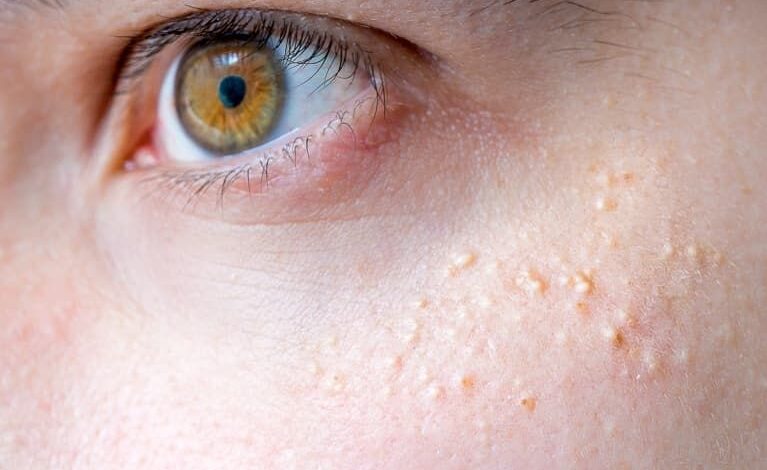Dealing with Milialar: Effective Strategies for Treating Superficial Keratin Cysts

Are you tired of those pesky little bumps that seem to appear out of nowhere on your skin? Fret not, because we have the answer! In today’s blog post, we’re diving deep into the world of milialar and sharing some effective strategies for treating these stubborn superficial keratin cysts.
Say goodbye to those unwelcome surprises and hello to smooth, flawless skin. Get ready to unlock the secrets behind achieving a blemish-free complexion – it’s time to take control!
What is Milialar?
Milialar are benign, slow-growing skin tumors. They can occur anywhere on the body but are most commonly found on the head and neck. They are treated with surgery or radiation therapy.
The National Cancer Institute has more information about milialar.
Causes of Milialar
Superficial keratin cysts are common skin conditions that can develop in any area of the body. They are harmless, but can be bothersome and may require treatment. There are many possible causes of superficial keratin cysts, but most common ones include:
- Hydrolysis of the stratum corneum (the outermost layer of the skin)
- Inflammation
- Sebaceous gland hyperplasia (a benign tumor of the sebaceous gland)
- Acne vulgaris (acne)
- Trauma
- Age
Symptoms of Milialar
Milialar are benign skin growths that can occur on any part of the body. They are usually painless, but may occasionally cause irritation. Treatment options for milialar include topical medication and surgery.
The most common symptoms of milialar include:
- Irritation
- Redness
- Pain
Treatment of Milialar
Milialar are benign skin lesions that are most commonly found on the face, neck, and upper extremities. Treatment typically involves surgical removal of the lesion. However, there are a number of effective treatments available for milialar.
Some people prefer to treat milialar with cryotherapy. This involves freezing the lesion in place with a cryotherapy device. Cryotherapy is a safe and effective treatment option for milialar lesions that do not require surgery.
Other treatments that are sometimes used to treat milialar include excisional biopsy and laser therapy. Excisional biopsy is an outpatient procedure that involves removing a small sample of the lesion for examination under a microscope. Laser therapy is an option for people who want to avoid surgery. The laser vaporizes the skin surface around the lesion, reducing its size.
Side Effects of Milialar
Superficial keratin cysts are benign lesions that can develop on the skin. They are caused by a proliferation of keratinocytes, a type of skin cell. Treatment options include topical treatments, laser therapy, and surgery.
Topical Treatments:
The most common treatment for superficial keratin cysts is topical application of a topical cream or solution. This approach involves applying the medication directly to the lesion. Topical corticosteroids are often used as initial treatment because they can reduce the size and number of lesions.
If compared with other treatments, topical corticosteroids have lower rates of side effects and are more effective in reducing the size of lesions. However, long-term use of topical corticosteroids is associated with some potential side effects, such as skin thinning and increased susceptibility to dermatitis (a condition that causes inflammation). Therefore, it is important to carefully monitor patients who receive this type of treatment.
Topical retinoids also have been shown to be effective in treating superficial keratin cysts. These medications work by reducing the production of melanin, which is responsible for the coloration of hair and skin cells.
Topical retinoids are less likely than corticosteroids to cause side effects and may be more tolerable for patients. However, retinoid use can lead to sun sensitivity and possible photoaging (the gradual development of wrinkles due to exposure to sunlight).
Prevention of Milialar
There is no silver bullet for preventing milialar, but there are effective strategies that can be used to reduce the risk. Here are some tips:
1. Stay up-to-date on new treatments and developments.
2. Be proactive about skin health and keep your skin clean and healthy.
3. Avoid sun exposure and use sunscreen when outdoors.
4. Check for signs of milialar early and get treated if possible.
5. Educate your family and friends about the dangers of milialar and how to avoid them.
Home Remedy to Cure Milialar
There are a few home remedies that can be used to cure milialar. Wearing sunscreen and staying out of the sun can help prevent the development of these lesions in the first place.
Treatment options include topical creams or ointments, oral antibiotics, and cryotherapy (using a device that freezes the lesion).
Topical creams or ointments: Some topical treatments available over the counter include benzoyl peroxide, sulfacetamide sodium, lactic acid, and salicylic acid. These agents work by exfoliating the skin and killing the bacteria that is responsible for developing milialar lesions.
It is important to note that some topical creams may cause irritation, so it is important to test a small amount on your skin before using it on a larger area.
Oral antibiotics: If you are experiencing moderate to severe symptoms, your doctor may prescribe an antibiotic such as doxycycline or amoxicillin. Oral antibiotics work by destroying the bacteria associated with milialar lesions.
Side effects from taking oral antibiotics include diarrhea, nausea, and vomiting. It is important to keep track of your medication levels and report any unusual side effects to your doctor.
Cryotherapy: Cryotherapy is a treatment option that uses cold temperatures to freeze the lesion. Cryotherapy has been shown to be effective in treating milialar lesions in both adults and children. The procedure is typically done at a hospital outpatient clinic or at home using
Conclusion
Milialar is a common skin condition that can be frustrating and difficult to treat. In this article, we discuss some effective strategies for treating milialar, including topical treatments, laser therapy, and excisional surgery. We hope that this information will help you find the best treatment for your individual case and enable you to get back to living your life without concern for Milialar.
You Might Also Like:




